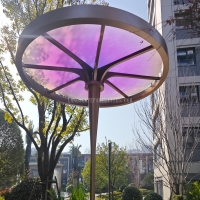Welcome to the website for landscape facilities products and knowledge.
How does the trash can’s design accommodate the disposal of industrial waste?
The design of industrial trash cans plays a critical role in efficient and safe waste management for manufacturing, construction, and other heavy industries. Unlike residential bins, industrial waste containers incorporate specialized features to handle unique challenges.
1. Durability & Material: Industrial bins use reinforced steel, thick polyethylene, or corrosion-resistant alloys to withstand harsh chemicals, heavy loads, and extreme temperatures. Many include reinforced bases to prevent cracking under weight.
2. Safety Enhancements: Designs often feature fire-resistant coatings, airtight seals for hazardous materials, and anti-microbial liners to prevent contamination. Lockable lids and tamper-proof mechanisms ensure compliance with OSHA and EPA regulations.
3. Ergonomic Handling: Larger bins (up to 100+ gallons) integrate forklift pockets, rolling casters, or hydraulic lift systems for easy transport. Some models include automated compactors to maximize capacity.
4. Segregation Systems: Color-coded compartments and smart sensors help separate recyclables, toxic waste, and general debris—key for industries with strict sustainability mandates.
5. Environmental Adaptations: Outdoor industrial bins may include weatherproof covers, drainage systems for liquid waste, and UV-resistant materials to prevent degradation.
These design innovations address industrial-scale waste volumes while minimizing workplace hazards and environmental impact—a necessity in sectors generating 7.6 billion tons of waste annually (EPA data). Modern solutions even incorporate IoT sensors for real-time fill-level monitoring, streamlining collection routes and reducing operational costs.
Related search:

Recommendation
Metal frame with gradient color acrylic combined with high-end shading landscape facilities